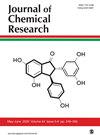Al3+-modified ZnO thin film sensor fabricated by the sputtering method: Characterization and a carbon monoxide gas detection study
IF 1.2
4区 化学
Q4 CHEMISTRY, MULTIDISCIPLINARY
引用次数: 0
Abstract
Al: ZnO films are prepared by spraying from the pure ZnO and Al with doping at different weight ratios 0.01, 0.03, 0.05, and 0.09. X-ray diffraction, atomic force microscopy, and energy-dispersive X-ray spectroscopy are used to analyze the structural properties of the films. The results of X-ray diffraction prove that polycrystalline Al:ZnO with a hexagonal wurtzite structure is preferentially oriented on the c-axis, and this is further confirmed by transmission electron microscopy. In addition, 0.09 wt% of Al-doping shows high orientation and homogeneity with the (002) plane, which leads to an increase in the surface roughness properties of the thin films as the root main square by 57.4%. The annealing process at high temperatures increases the conductivity of the Al:ZnO films. The rate of electronic mobility increases slightly with low doping and decreases with increasing doping until it reaches its lowest value (0.1 cm2 (V.s)−1) at a doping ratio of 0.035 wt%. The samples show considerable response for CO at 80 ppm gas concentration with gas responses of 85% and 40% at 90 °C for 0.03 wt% Al:ZnO and ZnO films, respectively. The overall study observed that fabricated sensor Al3+-doped ZnO is reliable and very rapid in detecting carbon monoxide vapors at moderately high temperatures and low gas concentrations.用溅射法制造的 Al3+ 改性氧化锌薄膜传感器:表征和一氧化碳气体检测研究
Al: ZnO 薄膜是由纯 ZnO 和以不同重量比 0.01、0.03、0.05 和 0.09 掺杂的 Al 喷涂制备而成。利用 X 射线衍射、原子力显微镜和能量色散 X 射线光谱分析了薄膜的结构特性。X 射线衍射结果证明,多晶 Al:ZnO 具有六方菱面体结构,优先在 c 轴上取向,透射电子显微镜进一步证实了这一点。此外,0.09 wt% 的铝掺杂显示了与 (002) 平面的高取向性和均匀性,这导致薄膜的表面粗糙度以主次方根为单位增加了 57.4%。高温退火过程提高了 Al:ZnO 薄膜的导电性。电子迁移率在低掺杂时略有增加,随着掺杂量的增加而降低,直到掺杂比为 0.035 wt% 时达到最低值(0.1 cm2 (V.s)-1)。样品在 80 ppm 气体浓度下对一氧化碳有相当大的响应,0.03 wt% Al:ZnO 和 ZnO 薄膜在 90 °C 时的气体响应分别为 85% 和 40%。总体研究结果表明,所制造的传感器 Al3+ 掺杂氧化锌在中等高温和低气体浓度下检测一氧化碳蒸气时非常可靠和快速。
本文章由计算机程序翻译,如有差异,请以英文原文为准。
求助全文
约1分钟内获得全文
求助全文
来源期刊

Journal of Chemical Research
CHEMISTRY, MULTIDISCIPLINARY-
CiteScore
2.30
自引率
0.00%
发文量
66
审稿时长
1.0 months
期刊介绍:
The Journal of Chemical Research is a monthly journal which has a broad international authorship and publishes research papers and reviews in all branches of experimental chemistry. Established in 1977 as a joint venture by the British, French and German chemical societies it maintains the high standards set by the founding societies. Each paper is independently peer reviewed and only carefully evaluated contributions are accepted. Recent papers have described new synthetic methods, new heterocyclic compounds, new natural products, and the inorganic chemistry of metal complexes.
 求助内容:
求助内容: 应助结果提醒方式:
应助结果提醒方式:


